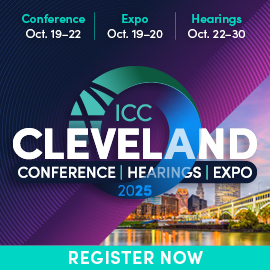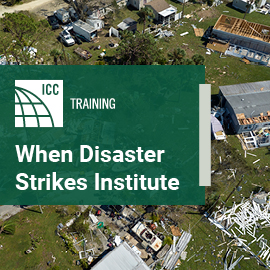
ICC-SRCC, Partners, Promote Free Training in Solar Energy Construction for Members through STEP Program
Eileen Prado has a message for code officials and others in the building industry that might be missing the wave of the future.
“Whether you know about renewable energy or not, it’s coming to your town. We want to help you understand it.”
To that end, Prado, executive director of the International Code Council Solar Rating Certification Corporation (ICC-SRCC), one of the newest members of ICC’s Family of Companies, wants members to know help is available for professionals outside the solar industry to learn more about solar permitting and inspecting solar installations.
More code professionals are coming in contact with solar technologies in their day-to-day jobs, she noted, including electrical and building inspectors, local code officials and firefighters, and all have an important role in the rapidly changing clean energy economy.
Recognizing this need, the ICC-SRCC partnered with the Interstate Renewable Energy Council (IREC), the International Association of Electrical Inspectors (IAEI), the International Association of Fire Fighters (IAFF) and the National Association of State Fire Marshals (NASFM) to promote a solar resources and training program that integrates solar training into existing professional development platforms and provides training to code officials about solar installations.
Called Solar Training and Education for Professionals (STEP), the two-year program is funded through a $2 million grant through the U.S. Department of Energy’s (DOE’s) Sun- Shot Initiative. This fund has allowed ICC-SRCC to offer this meaningful and valuable training to ICC members free of charge.
To date, the ICC-SRCC has issued Continuing Education Units (CEUs) to nearly 1,100 ICC members in 24 metropolitan areas across the United States through the STEP training. ICCSRCC is an ICC Preferred Provider.
“Building and fire officials, along with the other stakeholders the STEP award aims to reach, are key components in the continued growth of the U.S. solar industry,” Prado said.
“We hope to address gaps in training and education for code officials and other industry professionals who play a critical role in solar deployment, and give consumers access to highly-trained professionals working to provide a safe, affordable, resilient, and energy efficient built environment.”
“If market growth in the solar sector is to continue in a safe and sustainable way, quality workforce training for industries that touch solar is imperative in order to enhance their expertise and add to their professional development toolkits,” says IREC president/CEO Larry Sherwood. “Our collaboration with ICC-SRCC and IAEI through the STEP project recognizes that we all have an important role in the rapidly changing clean energy economy.
With ICC-SRCC already a trusted source of information for code officials and AHJs [Authorities Having Jurisdiction], they are a natural partner for IREC to turn to.”
Laure-Jeanne Davignon, IREC director of workforce and credentialing and principal investigator on the STEP award, agreed.
“Leveraging the same best practices we apply to our other clean energy training projects, the impact of this project is designed to go well beyond the two-year award period, increasing the number of Americans who can afford to access solar energy, and perpetuating a value chain that gives consumers confidence in the safety and results of solar installations.”
Fire officials need to know what they’re dealing with when they handle a call involving solar set-ups.
“The STEP project will position the IAFF to continue to provide our 300,000-plus members in the North American fire service with access to training and equipment to safely and effectively respond to incidents involving solar power energy systems,” said Harold A. Schaitberger, IAFF General President.
“We look forward to our continued work with the Interstate Renewable Energy Council to achieve this goal.”
Although it was adopted into the ICC family in 2014, SRCC is not a new organization, according to Prado. It was formed in 1984 by a partnership between the Department of Energy, the Solar Energy Industry Association and a handful of states. “During the oil crises of the 1970s, many companies and products were developed without any type of regulation or certification,” she said.
SRCC aimed to address solar regulations and certifications, Prado said, but in those days the focus was on solar thermal energy using heat from the sun—instead of traditional methods to heat water, space, and drive machinery.
While solar-thermal energy still is used widely today, Prado said the focus during the past 10 years or so has been on photovoltaic (PV) systems, where the sun is used to generate electricity.
In fact, she said, there are more than one million solar installations now on homes and businesses throughout the United States, “and that’s just scratching the surface.” Under the STEP grant, ICC-SRCC has been working to address that need.
Since the STEP curriculum was developed, those taking the free, six-hour, interactive course learn that:
- Quantity and spacing of array structural attachments are appropriate according tostructural table and manufacturer’s installation instructions for existing roof framing members and racking.
- Location of the roof top array meets requirements for access pathways and fire setbacks as required in local code—International Fire Code (IFC 605.11) or NFPA 1 (section 11.12) or other local code.
- Attachments’ weather sealing detail is correct according to International Residential Code (IRC) section R909.3 and product installation instruction.
- AC/DC conductor size and type are correct in accordance with NEC Chapter 3, 690.7, 690.8 and 690.31.
- The module/rack combination achieves the required fire classification and bonding in accordance with UL 1703, UL 2703, NEC 690.43 and 690.45.
- Plan includes description of all marking and labeling in accordance with IFC 605.11 or NFPA 1 (section 11.12) and IRC R331.2, NEC 690.17, NEC 690.31, NEC 690.53, and NEC 690.56.
- The quantities of micro-inverters or AC modules per branch circuit are correct in accordance with manufacturer’s instructions and NEC 690.8.
- All required disconnecting means, types and locations are specified on plan in accordance with NEC 690.13 – 690.17 and/or utility.
- The existence of a rapid shutdown system (RSS) in accordance with NEC 690.12. 10. The location and rating of the PV system over-current protective device is in accordance with NEC 690.8 and 705.12.
In fact, some say the course should be 12 hours,” Prado said. “We provide sets of plans and need large tables so participants can review them as we go along. It’s not an easy class. It’s very comprehensive.”
That’s why a six-hour course set as part of the Code Council’s Annual Conference and Building & Safety Design Expo in September in Columbus, Ohio, was limited to 100 participants,she said, noting the program filled up several weeks before the event.
“We are excited to be working with IREC and our industry partners on the SunShot Initiative project,” said IAEI CEO David Clements. “We are pleased to contribute to the deployment of high-quality solar training to electrical inspectors, installers and designers for the benefit of all involved in today’s fast-growing renewable energy and energy efficiency industries.
“And because resources and training will be integrated into existing professional training programs, it won’t end with this collaboration.”
When the two-year STEP award through DOE runs out, Prado said the training will continue through existing training programs, and hopefully expand into code inspections and regulations for wind power energy storage and solar-thermal, which would need to include insights into plumbing requirements, fire safety and electrical.
But for now, she said, she’ll be glad to set up ICC chapters with the free, six-hour, in-person class on how to handle PV plans and permits, “anywhere the sun shines.”
For more information on the STEP training, contact Prado at eprado@iccsafe.org.







